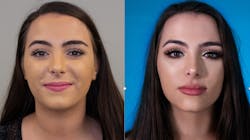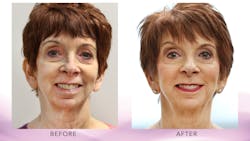The esthetic Zoom boom
Why has there been an explosion of consumer interest in esthetic dentistry and facial esthetics since we’ve been back in our offices post–COVID-19 shutdown?
There is something called the “lipstick effect” that was anecdotally described dating back to post-World War II, post-9/11, and most recently, post-2008 recession. The theory is that after a national or international shakeup, consumers will spend on beauty products and services that make them feel better about themselves and feel more attractive.1
And it wasn’t just lipstick in 2008—the dramatic rise in consumer interest and sales of noninvasive esthetic treatment such as teeth whitening, porcelain veneers, and Botox began after the Great Recession.2 Dentists started to offer Botox and fillers to their patients, and at the time this was considered unusual but is now mainstream. Botox and dermal fillers are easy to deliver once you are properly trained; they’re affordable; and they can be accomplished in as few as 15 minutes. I remember during the 2008 recession, many in our profession thought that esthetic dentistry was finished. It took a few years for it to make a comeback because it is very involved, expensive, and requires a big commitment from a patient.
Here we are post–COVID-19 shutdown, and there is an even bigger interest in dental and facial esthetics, even more so than the lipstick effect of 2008. It is what I have described as the Zoom Effect. Video conferencing is now a big part of our lives, whether for continuing education, school, getting together with friends, teledentistry, and more. This has created an entirely new dimension to patients’ desire to look better quickly.
What don’t patients like about their own dental and facial esthetics when they see themselves close-up on Zoom? First, poor lighting does no favors to anyone. Second, many built-in laptop and phone cameras use a wide-angle lens. which means the closer you get to the camera, the more distorted your facial image. Third, the angle of these cameras is usually pointed from the lower face up, therefore patients can see their deep smiles lines and lips lines, jowls, chin deficiency, double chins, wrinkled necks, and of course, their discolored and misaligned teeth.
Patients have been staring at their own faces for months on Zoom and many do not like what they see. This sent many people, as soon as the restrictions were lifted, to seek esthetic self-care.
Simple and affordable
As of June 15, the American Dental Association Health Policy Institute found that 97% of the 5,000 dental offices polled were offering elective care and were at 65% patient volume compared to pre-COVID.3 On June 30, an internal American Academy of Facial Esthetics member study found that members who offered injectable therapy from the first day they reopened experienced an 18% rise in injectable production compared to pre-COVID, nearly 85% patient volume, and a 12% rise in new patients for injectable treatment.4
Many of these dentists provided injectable therapy and emergency care only for the first few weeks because the appointment times are short, they could see more patients, and it helped generate income until they felt comfortable with controlling dental aerosols. These dentists also reported an increase in dental whitening because it is a simple treatment that is cost effective with immediate benefits. Dental esthetics, such as porcelain veneers and implant therapy, have lagged because of the cost and time factors involved.
Zoom lessons
Here are the lessons learned from the Zoom Effect. The time is now to invest in yourself and your practice and learn how to excel at dental implants and noninvasive veneers. Receive certification training in Botox and dermal fillers and add them to your practice. Facial esthetics is dental esthetics and dental esthetics is facial esthetics.
With the Zoom Effect, the bulk of patients are seeking the best esthetics through simple procedures that give them immediate improvement at a reasonable cost. This includes injectable therapy such as Botox and fillers, dental whitening, resin veneers, and single-tooth implants. Let these procedures be the gateway to more comprehensive dental esthetics as the post-COVID rebound continues. Become trained today!
References
1. Hill SE, Rodeheffer CD, Griskevicius V, Durante K, White AE. Boosting beauty in an economic decline: mating, spending, and the lipstick effect. J Pers Soc Psychol. 2012;103(2):275-291. doi:10.1037/a0028657
2. Gross D. Botox economy: Why Allergan is the perfect American company. Newsweek. October 8, 2012. https://www.newsweek.com/botox-economy-why-allergan-perfect-american-company-65361
3. Dental practices continue to recover, according to HPI poll. ADA News. June 22, 2020. https://www.ada.org/en/publications/ada-news/2020-archive/june/dental-practices-continue-to-recover-according-to-hpi-poll4. American Academy of Facial Esthetics member study. July 1, 2020.
LOUIS MALCMACHER, DDS, MAGD, is a practicing general dentist and an internationally known lecturer and author. Dr. Malcmacher is president of the American Academy of Facial Esthetics (AAFE). You can contact him at (800) 952-0521 or [email protected]. Visit facialesthetics.org, where you can find information about live patient Botox and dermal fillers training, solid filler PDO threadlifts, frontline TMJ/orofacial pain training, dental sleep medicine, bruxism therapy, and to sign up for a free monthly enewsletter.
About the Author

Louis Malcmacher, DDS, MAGD
Louis Malcmacher, DDS, MAGD, is a practicing general dentist and an internationally known lecturer and author. He is the president of the American Academy of Facial Esthetics (AAFE). You can contact him at (800) 952-0521 or [email protected]. Go to facialesthetics.org for information about live-patient Botox and dermal fillers training, solid-filler PDO thread lifts, frontline TMJ and orofacial pain training, dental sleep medicine, bruxism therapy and medical insurance, and to sign up for a free monthly e-newsletter.

